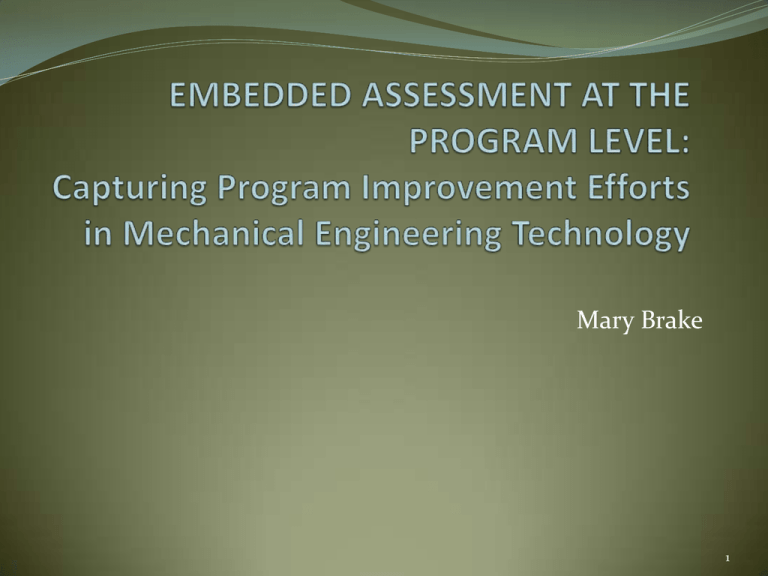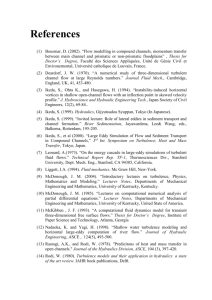Mary Brake 1
advertisement

Mary Brake 1 IMPLEMENT 1. Program Review The model: Continuous Improvement The goal: Establish student learning outcomes for program, and Show that students have met these outcomes. 2. Method Link program outcomes to courses Combine multiple program outcomes into groups Use multiple methods to evaluate program outcomes Use embedded assessment to evaluate course objectives 2 ASSESS Use embedded assessments to: - Assess for applying concepts learned in previous courses needed to understand more complex concepts in follow on courses. - Assess for concepts learned in a particular course. - Assess ability to combine multiple concepts to show that students have mastered “the knowledge, techniques, skills and modern tools of MET” 3 ANALYZE CONCEPTS TAUGHT IN PREVIOUS COURSE(s) Example: In Fluid Mechanics students must remember how to use certain concepts from Statics and Dynamics. HW Question: See next slide Concept: In addition to applying the general concepts of “submerged bodies”, students must use the concept of taking a moment about a particular point. (Think torque) Assessment: use rubric to determine students ability to apply previous , often theoretical, concepts to this real problem. This gives an idea of the overall class understanding Note: The grade on this question may or may not match “grade” the student receives on the rubric. 4 Example Problem using Prior Knowledge A rectangular gate is installed in a vertical wall of a reservoir. Compute the magnitude of the resultant force on the gate and the location of the center of pressure. Also compute the force on each of the two latches. From “Applied Fluids Mechanics” by Robert L. Mott (2006) Prentice Hall 5 Example of student who knows the fluid mechanics but not how to take a moment Did not find the force on the latches because student did not remember or did not know how to take the moment. Used with permission 6 Example of student who knows the fluid mechanics and prior knowledge Used with permission 7 ASSESS PRIOR KNOWLEDGE Student Doesn’t understand the fluid concepts nor that a moment is needed to solve problem Can solve fluid mechanics but doesn’t see that the moment Eqn. is needed. Can set up the fluid mechanics and knows moment Eqn. is needed but can’t remember how to solve Knows that the moment Eqn. is needed and knows how to apply it in solving fluid mechanics problems 0 1 2 3 1 x 2 x 3 x 4 x 5 x 6 x … 15 x 8 ANALYZE AND ADJUST ANALYZE Class average = 2 Conclusion: In general, students knew the fluids mechanics and how to set up the problem but either remembered the moment equation and how to solve it or did not remember the moment equation at all. ADJUST Review how to apply the moment equation to a simple problem, then assign practice problems using the moment equation. Discuss with colleagues how to spend more time on this concept in prerequisite courses. Just a thought – carrots work better than sticks Give small amount of extra credit for the homework. It is amazing what students will do for extra credit! 9 ANALYZE CONCEPTS TAUGHT IN CURRENT COURSE(s) Example: Students think they understand turbulent flow and where it occurs, but do they? Exam Question: Draw the flow lines and turbulence (if it exists) for the following situations. Concept: When turbulence occurs, it occurs around back edges of objects (usually). Assessment: Have students draw the flow lines are two simple objects for laminar and turbulent flow 10 Student who understands the difference between turbulent and laminar flow and where turbulence occurs. 11 Student who does not understand turbulent flow or even how to draw an air foil Used with permission 12 ASSESS COURSE CONTENT KNOWLEDGE Student Can’t draw correct flow lines or areas of turbulence Can draw flow lines but not air foils. Can correctly draw flow lines but does not know where turbulence occurs. Can correctly draw flow lines, air foils, and position of turbulence. 0 1 2 3 1 x 2 x 3 4 x x 5 6 … 14 x x x 13 ANALYZE AND ADJUST ANALYZE Class average = 2.5 Conclusion: Students have fundamental idea of the concept of flow lines and how the flow travels around an object. A few don’t understand where turbulence occurs. ADJUST Implement additional experiments to increase visual knowledge. 14 ASSESS MASTERY OF SEVERAL CONCEPTS IN A SENIOR COURSE Example/Concept: In “Mechanical Vibrations” students need to combine their knowledge of statistics, dynamics, and strength of materials to learn how to analyze systems that vibrate. Essay : Please type a one to two page essay describing a vibration problem you see at work (or have seen in the past) and answer the following: “If you were in charge of fixing this problem, what would you do or if the problem was fixed, what was done?” Assessment: Does their essay illustrate a knowledge of vibrations and the underlying concepts. 15 Gather Evidence of What a Student Knows “CMM stands for Coordinate Measuring Machine and it is a quick and accurate means of dimensionally checking manufactured parts to be within the tolerances specified by the correct controlled print…. During plant layout planning I was requested for input on needs for the CMM lab. I did a layout of our lab that included … a request (for) … CMM on an isolated foundation. Nothing was done as I requested. “We got (a) … a stamping press. The press is a large mechanical slanted press and is just outside of the CMM lab. The press stamps parts in a zigzag direction, which means that it moves in the vertical and horizontal directions during operation. This caused an increase in vibration of the plant floor. “I (did) a study on how much the vibration (affected) the CMM … when calibration of probe … a variance of target measurement of 0.2 mm (was observed and) when (the stamping) press was not running, a variance of 0.00005 mm (was measured). “I proposed the solution was to move the CMM and cut the floor where it stood. Remove the concrete. Dig a new foundation 6 feet deep ... A gap would be formed and filled with a rubber isolator between the new foundation and the plant floor. Then add Anti Vibration Mounts to the points of contact of CMM. The results of this would be very low natural frequency (-2 -3 Hz) and the disturbing frequency (greater than) 4Hz would (be) reduced by 90% …” Used with permission 16 ANALYZE AND ADJUST ANALYZE All students gave great examples and were able to described the problem and a solution. All students were so enthusiastic about their essay that each and every one of them requested to read their essay aloud to the class and give additional commentary. ADJUST No adjustments necessary, yet. Use this assignment again! 17 Take Home - Embedded Assessment: ASSESS ANALYZE IMPLEMENT Fosters professional development shifts unconscious competent to conscious reflection; As a narrative , it “captures” improvements for accountability; ADJUST … thus, humanizing assessment. Unconscious Competent Conscious Reflection Awareness of continuous improvement of student learning 18





